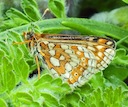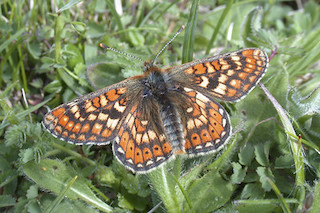 This small and delicate butterfly is a protected species due to its serious decline in numbers, but The Lizard is one of their strongholds. Find them on Mullion Cliffs or Goonhilly.
This small and delicate butterfly is a protected species due to its serious decline in numbers, but The Lizard is one of their strongholds. Find them on Mullion Cliffs or Goonhilly.
Photo: Amanda Scott
Scientific name: Euphydryas aurinia
Cornish name: ‘Tikki-dui’ is the general word for butterfly
Conservation status: Fully protected in Britain under the Wildlife and Countryside Act 1981; listed Appendix II, Bern Convention; listed Appendix II, EC Habitats and Species Directive; UK Biodiversity Action Plan, priority species
What to look for:
- Colouring : Upperside: strong patterning comprising orangey-brown markings on yellow-ish background. Underside: pale orange, yellow spots
- Size : A wingspan of 4.2 to 4.8 cm (males are smaller than females)
- Where : Damp grassland and heaths. The caterpillar foodplant, Devil’s-bit Scabious, must be present
- When : Flight period is May to July. Caterpillar webs visible from late summer
- Similar species : Other Fritillary butterflies, although this species has particularly bright colouring
 The Marsh Fritillary seems such an especially delicate butterfly, with its weak fluttering flight and small size, that it is easy to think that it must always have been as scarce as it is now. In fact, it was once present here in Britain and across Europe in much greater numbers. The very serious decline over the twentieth century is mainly due to agricultural intensification and habitat destruction across its range. Marsh Fritillaries are now fully protected in the UK and many efforts are being made to conserve the species. One success story is the continuing presence of colonies on the Lizard.
The Marsh Fritillary seems such an especially delicate butterfly, with its weak fluttering flight and small size, that it is easy to think that it must always have been as scarce as it is now. In fact, it was once present here in Britain and across Europe in much greater numbers. The very serious decline over the twentieth century is mainly due to agricultural intensification and habitat destruction across its range. Marsh Fritillaries are now fully protected in the UK and many efforts are being made to conserve the species. One success story is the continuing presence of colonies on the Lizard.
The strong orange and brown patterning of Marsh Fritillaries is very distinctive. They are not strong fliers, and spend much time resting on leaves and stems basking. The female lays her eggs on the underside of the leaves of the host plant, Devil’s-bit Scabious. After hatching, the gregarious caterpillars create webs to protect themselves from predators, and then overwinter together, usually in a web in tussocky grass close to the ground, before dispersing to pupate low in the grass or amongst dead leaves, and eventually emerge as the next generation of adults.
 Conservation measures for Marsh Fritillaries need to be carefully managed. Monitoring is somewhat complicated because this is a butterfly that naturally has fluctuating population levels. Grazing is helpful as it maintains a suitable sward height, but grazing by sheep is inappropriate as the animals eat the caterpillars’ foodplant. The ecology of Marsh Fritillaries also means they require that there are several locations with suitable habitat within the landscape to aid dispersal (i.e. they live in ‘metapopulations’), so it is not enough to improve only one or two habitats within an area.
Conservation measures for Marsh Fritillaries need to be carefully managed. Monitoring is somewhat complicated because this is a butterfly that naturally has fluctuating population levels. Grazing is helpful as it maintains a suitable sward height, but grazing by sheep is inappropriate as the animals eat the caterpillars’ foodplant. The ecology of Marsh Fritillaries also means they require that there are several locations with suitable habitat within the landscape to aid dispersal (i.e. they live in ‘metapopulations’), so it is not enough to improve only one or two habitats within an area.
Did you know…?
…Busy butterfly: females lay clutches of as many as 350 eggs.
…Individuals seldom fly further than 50 to 100 m, though some do disperse further afield.
More information and references:
Mansell, E. and Newman, L.H., 1968. The Complete British Butterflies in Colour. Ebury Press and Michael Joseph, London.
Wacher, J., Worth, J. and Spalding, A., 2003. A Cornwall Butterfly Atlas. Pisces Publications, Newbury, Berkshire.
Whalley, P. and Lewington, R., 2009. The Pocket Guide to Butterflies. Bounty Books, London.
Published: May 2014
Author: Amanda Scott
Photos: Upper, Amanda Scott; lower, © Allan Drewitt/Natural England
